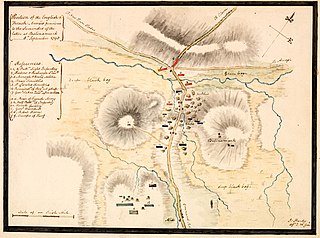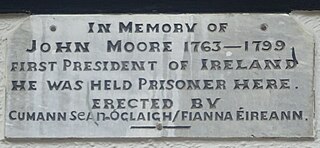1798 was a relatively quiet period in the French Revolutionary Wars. The major continental powers in the First coalition had made peace with France, leaving France dominant in Europe with only a slow naval war with Great Britain to worry about. The leaders of the Directory in Paris feared Napoleon Bonaparte's popularity after his victories in Italy, so they were relieved when he proposed to depart France and mount an expedition to Egypt to gain further glory.

The Irish Rebellion of 1798 was a major uprising against British rule in Ireland. The main organising force was the Society of United Irishmen, a republican revolutionary group influenced by the ideas of the American and French revolutions: originally formed by Presbyterian radicals angry at being shut out of power by the Anglican establishment, they were joined by many from the majority Catholic population.

Killala is a village in County Mayo in Ireland, north of Ballina. The railway line from Dublin to Ballina once extended to Killala. To the west of Killala is the townland of Townsplots West, which contains a number of ancient forts. Historically associated with Saint Patrick, and the seat of an episcopal see for several centuries, evidence of Killala's ecclesiastical past include a 12th century round tower and the 17th century Cathedral Church of St Patrick. As of the 2016 census of Ireland, the village had a population of 562.

Gerard Lake, 1st Viscount Lake was a British general. He commanded British forces during the Irish Rebellion of 1798 and later served as Commander-in-Chief of the military in British India.

Collooney or Coloony is a town in County Sligo, Ireland.

The Battle of Castlebar occurred on 27 August 1798 near the town of Castlebar, County Mayo, during the Irish Rising of that year. A combined force of 2,000 French troops and Irish patriots routed a combined force of 6,000-strong British and Protestant loyalist militia troops led by Gerard Lake, 1st Viscount Lake in what would later become known as the "Castlebar Races" or "Races of Castlebar".

General Jean Joseph Amable Humbert was a French military officer who participated in several notable military conflicts of the late 18th and early 19th century. Born in the townland of La Coâre Saint-Nabord, outside Remiremont Vosges, he was a sergeant in the National Guard of Lyon. He rapidly advanced through the ranks to become brigadier general on 9 April 1794 and fought in the Western campaigns before being allocated to the Army of the Rhine. Humbert also participated in the United Irishman Rebellion and the War of 1812.

The Battle of Ballinamuck marked the defeat of the main force of the French incursion during the 1798 Rebellion in Ireland.

John Moore was an Irish rebel leader, a United Irishman appointed in August 1798 "President of the Government of the Province of Connaught" by the commander of a French invasion force, General Humbert.

Kilcummin is a beachhead and civil parish on the northern coast of County Mayo in Ireland. Traditionally a fishing community, the Kilcummin area is sparsely populated. The "Tír Sáile - North Mayo Sculpture Trail" and "Tour d'Humbert" tourist route lead through the area. Kilcummin overlooks Killala Bay, the blue flag beach "An Trá nRoss", "Bartra Island" and lies on the opposite shore to Enniscrone and its beach in County Sligo.
Events from the year 1798 in Ireland.

Bartholomew Teeling was an Irish military officer and nationalist who was the leader of the rebel forces during the Irish Rebellion of 1798 and who carried out an act of bravery during the Battle of Collooney. He was captured at the Battle of Ballinamuck and subsequently executed for treason.

The Battle of Tory Island was a naval action of the French Revolutionary Wars, fought on 12 October 1798 between French and British squadrons off the northwest coast of County Donegal, then in the Kingdom of Ireland. The last action of the Irish Rebellion of 1798, the Battle of Tory Island ended the final attempt by the French Navy to land substantial numbers of soldiers in Ireland during the war.

The Battle of Killala was an engagement during the Irish Rebellion of 1798. It was fought on Sunday, 23 September 1798, between forces of the British Crown and a combined force of Irish rebels and a small number of French troops at Killala, County Mayo, Ireland.
Padraig Gearr Ó Mannin was a United Irishman who participated in the Irish Rebellion of 1798 in County Mayo.

British General Charles Cornwallis, the 1st Marquess Cornwallis was appointed in June 1798 to serve as both Lord Lieutenant of Ireland and Commander-in-Chief of Ireland, the highest civil and military posts in the Kingdom of Ireland. He held these offices until 1801.
Henry O'Keane was an Irish catholic priest and French army officer.
The Year of the French was a television serial, directed by Michael Garvey and based on the novel by Thomas Flanagan, which was first broadcast in 1982. It was a co-production by the Irish broadcaster RTÉ, the British television company Channel Four and the French broadcaster FR3, now France 3. The first episode was shown on RTÉ television on 18 November 1982. In France the programme was known as L'année des Français and was first broadcast on 23 May 1983.

Ballina is a town in north County Mayo, Ireland. It lies at the mouth of the River Moy near Killala Bay, in the Moy valley and Parish of Kilmoremoy, with the Ox Mountains to the east and the Nephin Beg mountains to the west. The town occupies two baronies; Tirawley on the west bank of the Moy River, and Tireragh, a barony within County Sligo, on its east banks. At the 2016 census, the population of Ballina was 10,171.

The Irish Republic of 1798, more commonly known as the Republic of Connacht, was a short-lived state proclaimed during the Irish Rebellion of 1798 that resulted from the French Revolutionary Wars. A sister republic of the French Republic, it theoretically covered the whole island of Ireland, but its functional control was limited to only very small parts of the Province of Connacht. Opposing British forces were deployed across most of the country including the main towns such as Dublin, Belfast and Cork.















